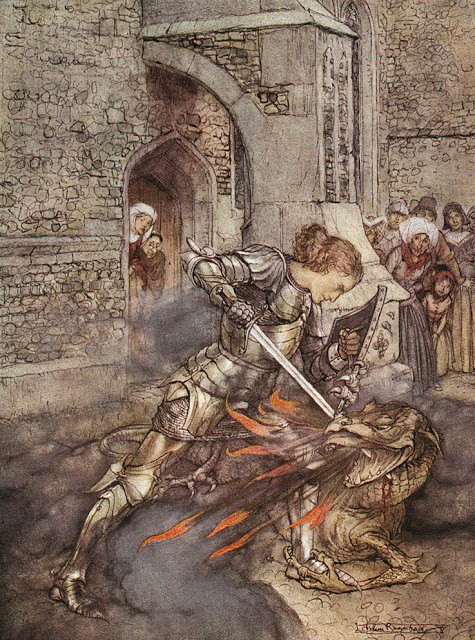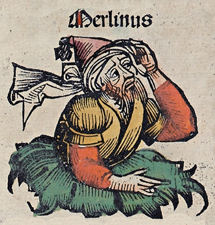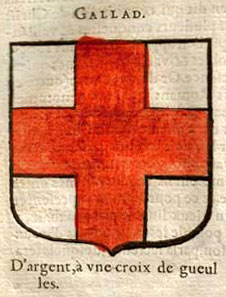|
Lancelot-Grail
The ''Lancelot-Grail'', also known as the Vulgate Cycle or the Pseudo-Map Cycle, is an early 13th-century French Arthurian literary cycle consisting of interconnected prose episodes of chivalric romance in Old French. The cycle of unknown authorship, presenting itself as a chronicle of actual events, retells the legend of King Arthur by focusing on the love affair between Lancelot and Guinevere as well as the religious quest for the Holy Grail, expanding on the works of Robert de Boron and Chrétien de Troyes. There is no unity of place, but most of the episodes take place in Arthur's kingdom of Logres. One of the main characters is Arthur himself, around whom gravitates a host of other heroes, many of whom are Knights of the Round Table. Among them is the famed Lancelot, whose chivalric tale is centered around his illicit romance with Arthur's wife, Queen Guinevere. However, the cycle also tells of adventures of a more spiritual type; those involve the Holy Grail, the vessel th ... [...More Info...] [...Related Items...] OR: [Wikipedia] [Google] [Baidu] |
Knights Of The Round Table
The Knights of the Round Table ( cy, Marchogion y Ford Gron, kw, Marghekyon an Moos Krenn, br, Marc'hegien an Daol Grenn) are the knights of the fellowship of King Arthur in the literary cycle of the Matter of Britain. First appearing in literature in the mid-12th century, the Knights are an order dedicated to ensuring the peace of Arthur's kingdom following an early warring period, entrusted in later years to undergo a mystical quest for the Holy Grail. The Round Table at which they meet is a symbol of the equality of its members, who range from sovereign royals to minor nobles. The various stories in the cycle present an assortment of knights from all over Great Britain and abroad, some of whom are even from outside of Europe. Their ranks often include King Arthur's family, Arthur's close and distant relatives, such as Agravain and Gaheris, as well as his reconciled enemies and those he defeated in battle, including Galehaut and King Lot, Lot. Several of the most notable kn ... [...More Info...] [...Related Items...] OR: [Wikipedia] [Google] [Baidu] |
Lancelot
Lancelot du Lac (French for Lancelot of the Lake), also written as Launcelot and other variants (such as early German ''Lanzelet'', early French ''Lanselos'', early Welsh ''Lanslod Lak'', Italian ''Lancillotto'', Spanish ''Lanzarote del Lago'', and Welsh ''Lawnslot y Llyn''), is a character in some versions of Arthurian legend, where he is typically depicted as King Arthur's close companion and one of the greatest Knights of the Round Table. In the French-inspired Arthurian chivalric romance tradition, Lancelot is an orphaned son of King Ban of the lost Kingdom of Benoic, raised in the fairy realm by the Lady of the Lake. A hero of many battles, quests and tournaments, and famed as a nearly unrivalled swordsman and jouster, Lancelot becomes the lord of the castle Joyous Gard and personal champion of Arthur's wife, Queen Guinevere, despite suffering from frequent and sometimes prolonged fits of madness. But when his adulterous affair with Guinevere is discovered, it causes a ci ... [...More Info...] [...Related Items...] OR: [Wikipedia] [Google] [Baidu] |
Merlin
Merlin ( cy, Myrddin, kw, Marzhin, br, Merzhin) is a mythical figure prominently featured in the legend of King Arthur and best known as a mage, with several other main roles. His usual depiction, based on an amalgamation of historic and legendary figures, was introduced by the 12th-century British author Geoffrey of Monmouth. It is believed that Geoffrey combined earlier tales of Myrddin and Ambrosius, two legendary Briton prophets with no connection to Arthur, to form the composite figure called Merlinus Ambrosius ( cy, Myrddin Emrys, br, Merzhin Ambroaz). Geoffrey's rendering of the character became immediately popular, especially in Wales. Later writers in France and elsewhere expanded the account to produce a fuller image, creating one of the most important figures in the imagination and literature of the Middle Ages. Merlin's traditional biography casts him as an often-mad being born of a mortal woman, sired by an incubus, from whom he inherits his supernatural powe ... [...More Info...] [...Related Items...] OR: [Wikipedia] [Google] [Baidu] |
Post-Vulgate Cycle
The ''Post-Vulgate Cycle'', also known as the Post-Vulgate Arthuriad, the Post-Vulgate ''Roman du Graal'' (''Romance of the Grail'') or the Pseudo-Robert de Boron Cycle, is one of the major Old French prose cycles of Arthurian literature from the early 13th century. It is considered essentially a rewriting of the earlier ''Vulgate Cycle'' (also known as the ''Lancelot-Grail'' cycle), with much left out but also much added, including characters and scenes from the Prose ''Tristan''. History The Post-Vulgate Cycle, written anonymously probably between 1230 and 1235 (different estimates of the beginning date) to 1240, is an attempt to create greater unity in the material, and to de-emphasise the secular love affair between Lancelot and Guinevere in favor of the Quest for the Holy Grail. It omits almost all of the Vulgate Cycle's ''Lancelot Proper'' section, making it much shorter than its source, and directly condemns everything but the spiritual life. It did not survive complete, ... [...More Info...] [...Related Items...] OR: [Wikipedia] [Google] [Baidu] |
Merlin (poem)
''Merlin'' is a partly lost French epic poem written by Robert de Boron in Old French and dating from either the end of the 12th or beginning of the 13th century. The author reworked Geoffrey of Monmouth's material on the legendary Merlin, emphasising Merlin's power to prophesy and linking him to the Holy Grail. The poem tells of his origin and early life as a redeemed Antichrist, his role in the birth of Arthur, and how Arthur became King of Britain. ''Merlin''s story relates to Robert's two other reputed Grail poems, ''Joseph'' and ''Perceval''. Its motifs became popular in medieval and later Arthuriana, notably the introduction of the sword in the stone, the redefinition of the Grail, and turning the previously peripheral Merlin into a key character in the legend of King Arthur. The poem's medieval prose retelling and continuations, collectively the Prose ''Merlin'', became parts of the 13th-century Vulgate and Post-Vulgate cycles of prose chivalric romances. The Prose ''Me ... [...More Info...] [...Related Items...] OR: [Wikipedia] [Google] [Baidu] |
Guinevere
Guinevere ( ; cy, Gwenhwyfar ; br, Gwenivar, kw, Gwynnever), also often written in Modern English as Guenevere or Guenever, was, according to Arthurian legend, an early-medieval queen of Great Britain and the wife of King Arthur. First mentioned in popular literature in the early 12th century, nearly 700 years after the purported times of Arthur, Guinevere has since been portrayed as everything from a villainous and opportunistic traitor to a fatally flawed but noble and virtuous lady. Many records of the legend also feature the variably recounted story of her abduction and rescue as a major part of the tale. The earliest datable appearance of Guinevere is in Geoffrey of Monmouth's pseudo-historical British chronicle ''Historia Regum Britanniae'', in which she is seduced by Mordred during his ill-fated rebellion against Arthur. In a later medieval Arthurian romance tradition from France, a prominent story arc is the queen's tragic love affair with her husband's chief knight ... [...More Info...] [...Related Items...] OR: [Wikipedia] [Google] [Baidu] |
Camelot
Camelot is a castle and court associated with the legendary King Arthur. Absent in the early Arthurian material, Camelot first appeared in 12th-century French romances and, since the Lancelot-Grail cycle, eventually came to be described as the fantastic capital of Arthur's realm and a symbol of the Arthurian world. The stories locate it somewhere in Great Britain and sometimes associate it with real cities, though more usually its precise location is not revealed. Most scholars regard it as being entirely fictional, its unspecified geography being perfect for chivalric romance writers. Nevertheless, arguments about the location of the "real Camelot" have occurred since the 15th century and continue today in popular works and for tourism purposes. Etymology The name's derivation is uncertain. It has numerous different spellings in medieval French Arthurian romances, including ''Camaalot'', ''Camalot'', ''Chamalot'', ''Camehelot'' (sometimes read as ''Camchilot''), ''Camaaloth ... [...More Info...] [...Related Items...] OR: [Wikipedia] [Google] [Baidu] |
Galahad
Sir Galahad (), sometimes referred to as Galeas () or Galath (), among other versions of his name, is a knight of King Arthur's Round Table and one of the three achievers of the Holy Grail in Arthurian legend. He is the illegitimate son of Sir Lancelot du Lac and Lady Elaine of Corbenic and is renowned for his gallantry and purity as the most perfect of all knights. Emerging quite late in the medieval Arthurian tradition, Sir Galahad first appears in the Lancelot–Grail cycle, and his story is taken up in later works, such as the Post-Vulgate Cycle, and Sir Thomas Malory's '' Le Morte d'Arthur''. Origins The story of Galahad and his quest for the Holy Grail is a relatively late addition to the Arthurian legend. Galahad does not feature in any romance by Chrétien de Troyes, or in Robert de Boron's Grail stories, or in any of the continuations of Chrétien's story of the mysterious castle of the Fisher King. He first appears in a 13th-century Old French Arthurian epic, the ... [...More Info...] [...Related Items...] OR: [Wikipedia] [Google] [Baidu] |
Le Morte D'Arthur
' (originally written as '; inaccurate Middle French for "The Death of Arthur") is a 15th-century Middle English prose reworking by Sir Thomas Malory of tales about the legendary King Arthur, Guinevere, Lancelot, Merlin and the Knights of the Round Table, along with their respective folklore. In order to tell a "complete" story of Arthur from his conception to his death, Malory compiled, rearranged, interpreted and modified material from various French and English sources. Today, this is one of the best-known works of Arthurian literature. Many authors since the 19th-century revival of the legend have used Malory as their principal source. Apparently written in prison at the end of the medieval English era, ''Le Morte d'Arthur'' was completed by Malory around 1470 and was first published in a printed edition in 1485 by William Caxton. Until the discovery of the Winchester Manuscript in 1934, the 1485 edition was considered the earliest known text of ''Le Morte d'Arthur'' and that ... [...More Info...] [...Related Items...] OR: [Wikipedia] [Google] [Baidu] |
King Arthur
King Arthur ( cy, Brenin Arthur, kw, Arthur Gernow, br, Roue Arzhur) is a legendary king of Britain, and a central figure in the medieval literary tradition known as the Matter of Britain. In the earliest traditions, Arthur appears as a leader of the post-Roman Britons in battles against Saxon invaders of Britain in the late 5th and early 6th centuries. He appears in two early medieval historical sources, the ''Annales Cambriae'' and the ''Historia Brittonum'', but these date to 300 years after he is supposed to have lived, and most historians who study the period do not consider him a historical figure.Tom Shippey, "So Much Smoke", ''review'' of , ''London Review of Books'', 40:24:23 (20 December 2018) His name also occurs in early Welsh poetic sources such as ''Y Gododdin''. The character developed through Welsh mythology, appearing either as a great warrior defending Britain from human and supernatural enemies or as a magical figure of folklore, sometimes associated wi ... [...More Info...] [...Related Items...] OR: [Wikipedia] [Google] [Baidu] |
Robert De Boron
Robert de Boron (also spelled in the manuscripts "Roberz", "Borron", "Bouron", "Beron") was a French poet of the late 12th and early 13th centuries, notable as the reputed author of the poems and ''Merlin''. Although little is known of him apart from the poems he allegedly wrote, his works and subsequent prose redactions of them had a strong influence on later incarnations of the Arthurian legend and its prose cycles, particularly through their Christian back story for the Holy Grail. Life Robert de Boron wrote ''Joseph d'Arimathe'' for a lord named Gautier de Montbéliard and he took on the name Boron from a village near Montbéliard in eastern France. What is known of his life comes from brief mentions in his own work. At one point in ''Joseph'', he applies to himself the title of ''meisters'' (medieval French for "clerk"); later he uses the title ''messires'' (medieval French for "knight"). At the end of the same text, he mentions being in the service of Gautier of "Mont Belyal" ... [...More Info...] [...Related Items...] OR: [Wikipedia] [Google] [Baidu] |
Matter Of Britain
The Matter of Britain is the body of medieval literature and legendary material associated with Great Britain and Brittany and the list of legendary kings of Britain, legendary kings and heroes associated with it, particularly King Arthur. It was one of the three great Western Literary cycle, story cycles recalled repeatedly in medieval literature, together with the Matter of France, which concerned the legends of Charlemagne, and the Matter of Rome, which included material derived from or inspired by classical mythology. History The three "Matters" were first described in the 12th century by French poet Jean Bodel, whose epic ' ("Song of the Saxons") contains the line: The name distinguishes and relates the Matter of Britain from the mythological themes taken from classical antiquity, the "Matter of Rome", and the tales of the Paladins of Charlemagne and their wars with the Moors and Saracens, which constituted the "Matter of France". King Arthur is the chief subject of th ... [...More Info...] [...Related Items...] OR: [Wikipedia] [Google] [Baidu] |
_Biblioteca_Nazionale_Centrale_di_Firenze.jpg)







